1. Lee SY, Lee KJ, Kim SJ, Cho SW. Prevalence and risk factors for overlaps between gastroesophageal reflux disease, dyspepsia, and irritable bowel syndrome: a population-based study. Digestion. 2009; 79(3):196–201. PMID:
19342860.
2. Lee YY, Waid A, Tan HJ, Chua AS, Whitehead WE. Rome III survey of irritable bowel syndrome among ethnic Malays. World J Gastroenterol. 2012; 18(44):6475–6480. PMID:
23197894.
3. Siah KT, Wong RK, Chan YH, Ho KY, Gwee KA. Prevalence of irritable bowel syndrome in Singapore and its association with dietary, lifestyle, and environmental factors. J Neurogastroenterol Motil. 2016; 22(4):670–676. PMID:
26951047.
4. Mearin F, Lacy BE, Chang L, Chey WD, Lembo AJ, Simren M, et al. Bowel Disorders. Gastroenterology. Forthcoming. 2016; DOI:
10.1053/j.gastro.2016.02.031.
5. Park DW, Lee OY, Shim SG, Jun DW, Lee KN, Kim HY, et al. The differences in prevalence and sociodemographic characteristics of irritable bowel syndrome according to Rome II and Rome III. J Neurogastroenterol Motil. 2010; 16(2):186–193. PMID:
20535350.
6. Gralnek IM, Hays RD, Kilbourne A, Naliboff B, Mayer EA. The impact of irritable bowel syndrome on health-related quality of life. Gastroenterology. 2000; 119(3):654–660. PMID:
10982758.
7. Ballou S, Keefer L. The impact of irritable bowel syndrome on daily functioning: characterizing and understanding daily consequences of IBS. Neurogastroenterol Motil. 2017; 29(4):e12982.
8. Buono JL, Mathur K, Averitt AJ, Andrae DA. Economic burden of inadequate symptom control among US commercially insured patients with irritable bowel syndrome with diarrhea. J Med Econ. 2017; 20(4):353–362. PMID:
27919177.
9. Chey WD, Kurlander J, Eswaran S. Irritable bowel syndrome: a clinical review. JAMA. 2015; 313(9):949–958. PMID:
25734736.
10. Brandt LJ, Chey WD, Foxx-Orenstein AE, Schiller LR, Schoenfeld PS, Spiegel BM, et al. An evidence-based position statement on the management of irritable bowel syndrome. Am J Gastroenterol. 2009; 104(Suppl 1):S1–35.
11. Gwee KA, Bak YT, Ghoshal UC, Gonlachanvit S, Lee OY, Fock KM, et al. Asian consensus on irritable bowel syndrome. J Gastroenterol Hepatol. 2010; 25(7):1189–1205. PMID:
20594245.
12. Hookway C, Buckner S, Crosland P, Longson D. Irritable bowel syndrome in adults in primary care: summary of updated NICE guidance. BMJ. 2015; 350:h701. PMID:
25716701.
13. Fukudo S, Kaneko H, Akiho H, Inamori M, Endo Y, Okumura T, et al. Evidence-based clinical practice guidelines for irritable bowel syndrome. J Gastroenterol. 2015; 50(1):11–30. PMID:
25500976.
14. Chang L, Lembo A, Sultan S. American Gastroenterological Association Institute Technical Review on the pharmacological management of irritable bowel syndrome. Gastroenterology. 2014; 147(5):1149–72.e2. PMID:
25224525.
15. Spiller R, Aziz Q, Creed F, Emmanuel A, Houghton L, Hungin P, et al. Guidelines on the irritable bowel syndrome: mechanisms and practical management. Gut. 2007; 56(12):1770–1798. PMID:
17488783.
16. Kwon JG, Park KS, Park JH, Park JM, Park CH, Lee KJ, et al. Guidelines for the treatment of irritable bowel syndrome. Korean J Gastroenterol. 2011; 57(2):82–99. PMID:
21350320.
17. Song KH, Jung HK, Kim HJ, Koo HS, Kwon YH, Shin HD, et al. Clinical practice guidelines for irritable bowel syndrome in Korea, 2017 revised edition. J Neurogastroenterol Motil. 2018; 24(2):197–215. PMID:
29605976.
18. Gwee KA, Gonlachanvit S, Ghoshal UC, Chua AS, Miwa H, Wu J, et al. Second Asian consensus on irritable bowel syndrome. J Neurogastroenterol Motil. 2019; 25(3):343–362. PMID:
31327218.
19. Lacy BE, Patel H, Guérin A, Dea K, Scopel JL, Alaghband R, et al. Variation in care for patients with irritable bowel syndrome in the United States. PLoS One. 2016; 11(4):e0154258. PMID:
27116612.
20. Soncini M, Stasi C, Usai Satta P, Milazzo G, Bianco M, Leandro G, et al. AIGO. IBS clinical management in Italy: the AIGO survey. Dig Liver Dis. 2019; 51(6):782–789. PMID:
30448159.
21. Staudacher HM, Whelan K. The low FODMAP diet: recent advances in understanding its mechanisms and efficacy in IBS. Gut. 2017; 66(8):1517–1527. PMID:
28592442.
22. Staudacher HM, Irving PM, Lomer MC, Whelan K. Mechanisms and efficacy of dietary FODMAP restriction in IBS. Nat Rev Gastroenterol Hepatol. 2014; 11(4):256–266. PMID:
24445613.
23. Bouras EP, Camilleri M, Burton DD, Thomforde G, McKinzie S, Zinsmeister AR. Prucalopride accelerates gastrointestinal and colonic transit in patients with constipation without a rectal evacuation disorder. Gastroenterology. 2001; 120(2):354–360. PMID:
11159875.
24. Ke M, Tack J, Quigley EM, Zou D, Choi SC, Leelakusolvong S, et al. Effect of prucalopride in the treatment of chronic constipation in Asian and non-Asian women: a pooled analysis of 4 randomized, placebo-controlled studies. J Neurogastroenterol Motil. 2014; 20(4):458–468. PMID:
25273116.
25. Pittayanon R, Lau JT, Yuan Y, Leontiadis GI, Tse F, Surette M, et al. Gut microbiota in patients with irritable bowel syndrome-a systematic review. Gastroenterology. 2019; 157(1):97–108. PMID:
30940523.
26. Ford AC, Talley NJ. Mucosal inflammation as a potential etiological factor in irritable bowel syndrome: a systematic review. J Gastroenterol. 2011; 46(4):421–431. PMID:
21331765.
27. Andresen V, Montori VM, Keller J, West CP, Layer P, Camilleri M. Effects of 5-hydroxytryptamine (serotonin) type 3 antagonists on symptom relief and constipation in nonconstipated irritable bowel syndrome: a systematic review and meta-analysis of randomized controlled trials. Clin Gastroenterol Hepatol. 2008; 6(5):545–555. PMID:
18242143.
28. Pimentel M, Lembo A, Chey WD, Zakko S, Ringel Y, Yu J, et al. Rifaximin therapy for patients with irritable bowel syndrome without constipation. N Engl J Med. 2011; 364(1):22–32. PMID:
21208106.
29. Lembo A, Pimentel M, Rao SS, Schoenfeld P, Cash B, Weinstock LB, et al. Repeat treatment with rifaximin is safe and effective in patients with diarrhea-predominant irritable bowel syndrome. Gastroenterology. 2016; 151(6):1113–1121. PMID:
27528177.
30. Chey WD, Shah ED, DuPont HL. Mechanism of action and therapeutic benefit of rifaximin in patients with irritable bowel syndrome: a narrative review. Therap Adv Gastroenterol. 2020; 13:1756284819897531.
31. Chey WY, Jin HO, Lee MH, Sun SW, Lee KY. Colonic motility abnormality in patients with irritable bowel syndrome exhibiting abdominal pain and diarrhea. Am J Gastroenterol. 2001; 96(5):1499–1506. PMID:
11374689.
32. Brenner DM, Moeller MJ, Chey WD, Schoenfeld PS. The utility of probiotics in the treatment of irritable bowel syndrome: a systematic review. Am J Gastroenterol. 2009; 104(4):1033–1049. PMID:
19277023.
33. Didari T, Mozaffari S, Nikfar S, Abdollahi M. Effectiveness of probiotics in irritable bowel syndrome: updated systematic review with meta-analysis. World J Gastroenterol. 2015; 21(10):3072–3084. PMID:
25780308.
34. Lee C, Doo E, Choi JM, Jang SH, Ryu HS, Lee JY, et al. The increased level of depression and anxiety in irritable bowel syndrome patients compared with healthy controls: systematic review and meta-analysis. J Neurogastroenterol Motil. 2017; 23(3):349–362. PMID:
28672433.
35. Shah E, Rezaie A, Riddle M, Pimentel M. Psychological disorders in gastrointestinal disease: epiphenomenon, cause or consequence? Ann Gastroenterol. 2014; 27(3):224–230. PMID:
24974805.
36. Black CJ, Yuan Y, Selinger CP, Camilleri M, Quigley EM, Moayyedi P, et al. Efficacy of soluble fibre, antispasmodic drugs, and gut-brain neuromodulators in irritable bowel syndrome: a systematic review and network meta-analysis. Lancet Gastroenterol Hepatol. 2020; 5(2):117–131. PMID:
31859183.
37. Ford AC, Lacy BE, Harris LA, Quigley EM, Moayyedi P. Effect of antidepressants and psychological therapies in irritable bowel syndrome: an updated systematic review and meta-analysis. Am J Gastroenterol. 2019; 114(1):21–39. PMID:
30177784.
38. Lacy BE, Pimentel M, Brenner DM, Chey WD, Keefer LA, Long MD, et al. ACG clinical guideline: management of irritable bowel syndrome. Am J Gastroenterol. 2021; 116(1):17–44. PMID:
33315591.
39. Oh SJ, Takakura W, Rezaie A. Shortcomings of trials assessing antidepressants in the management of irritable bowel syndrome: a critical review. J Clin Med. 2020; 9(9):2933. PMID:
32932856.
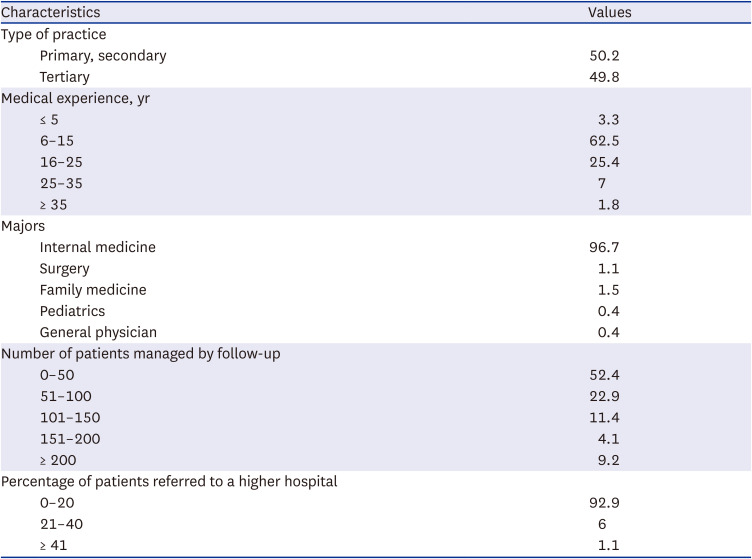
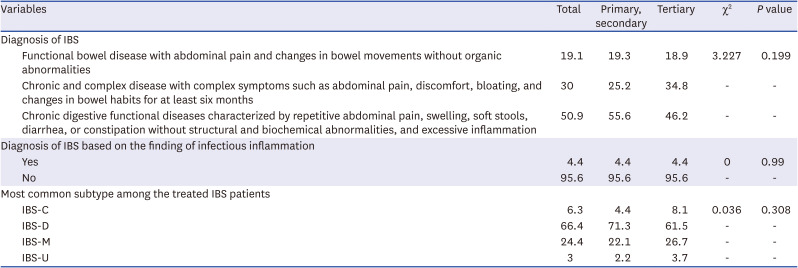
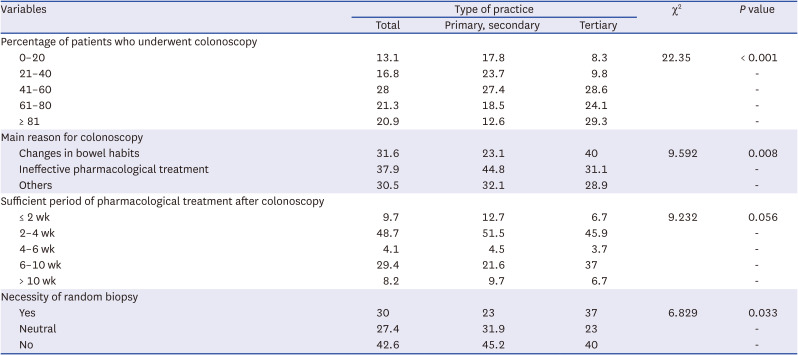
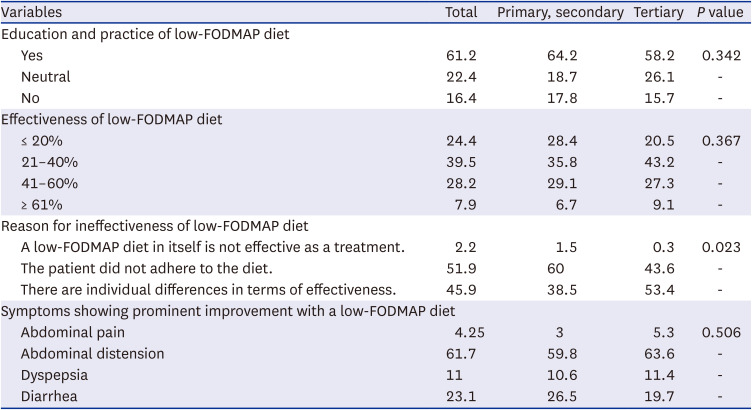


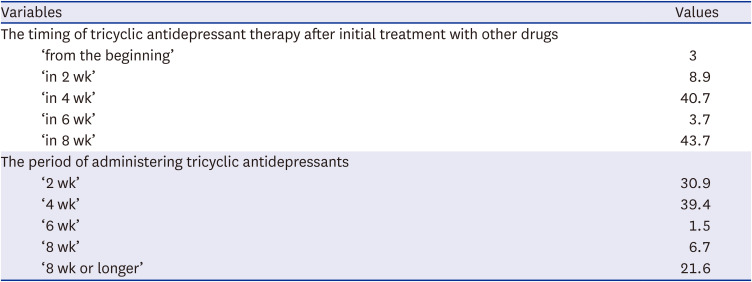




 PDF
PDF Citation
Citation Print
Print




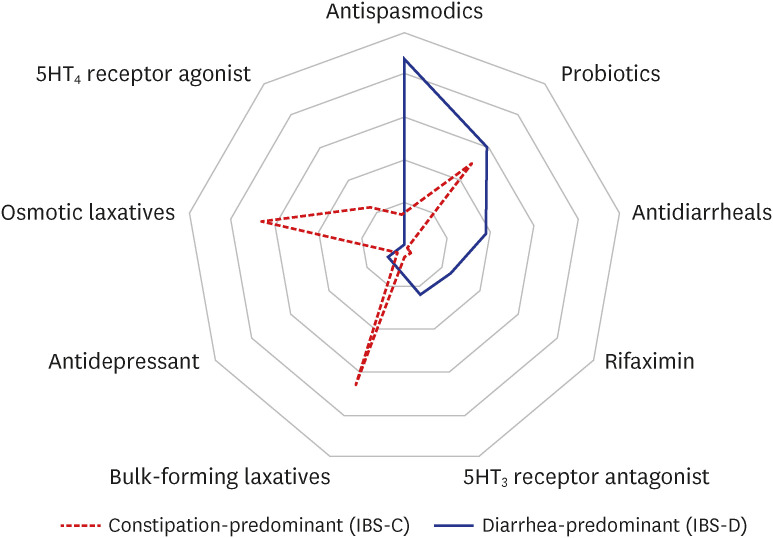
 XML Download
XML Download